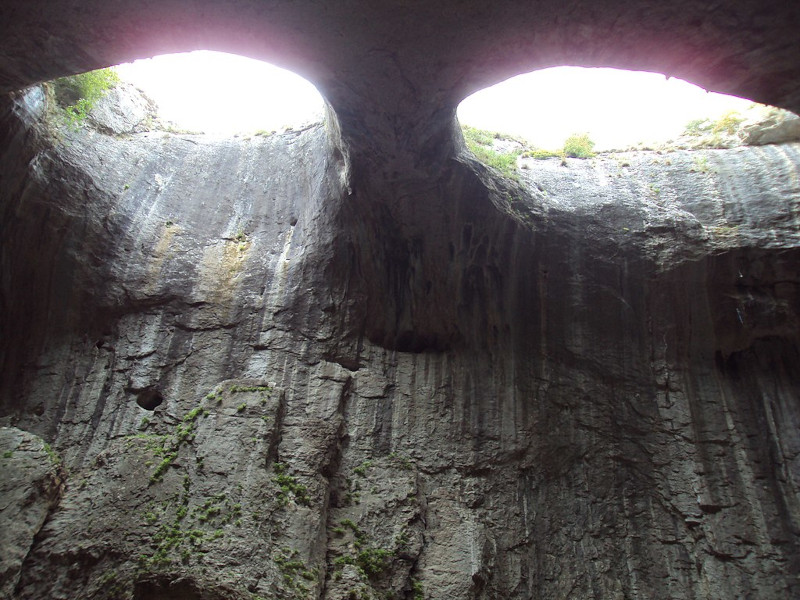Prohodna Cave Facts
- The term of Prohodna Cave serves as the most frequently used name for this stunning creation of natural forces. In the language of the surrounding region, the formation has another one, the original appellation, though. That’s the title of Проходна.
- The highly unique work of natural geological processes truly represents a most appealing and fascinating view of the works of Nature. The amazing site also represents an excellent example of a highly specific type of cave found in a part of Europe.
- But, its most easily recognizable feature remains the two distinctly eye-shaped openings located in the ceiling. Surprisingly, these natural openings coincidentally developed roughly the same size and shape. It thus makes for a truly remarkable sight.
- This rare and fascinating formation bears the name of Okanata. This roughly translates as windows in the native language of the region. Prohodna Cave understandably featured prominently in a locally produced film entitled Time of Violence.
- Given its astounding beauty and distinctiveness, one fact remains completely understandable. That’s the fact that this site ranks as one of the most popular tourist sites in the region. It also remains well known throughout the much of the world.
Related Articles
Prohodna Cave Physical Description
In addition to its beauty, the impressive Prohodna Cave itself ranks as a moderately large cave. That’s due to the fact that it measures roughly 860 ft (262 m) in length. This measurement also makes it the longest cave passage in the country it formed in.
This unquestionably magnificent wonder of geology also has two entrances. In an intriguing coincidence, these lay almost directly opposite each other. For the obvious reasons, these two structures bear the names of the Big Entrance and the Small Entrance.
The Big Entrance itself measures roughly 148 ft (45 m) in overall height. ironically, the dimensions of the other opening are not significantly smaller. That’s because the opening that’s named the Small Entrance itself measures an impressive 115 ft (35 m) high.
To further amaze us, Nature created yet another amazing feature within this already awesome location. That holds true because the efforts of entirely natural forces allowed for the two openings to form in roughly the center of the ceiling of the large chamber.
Incredibly, one more awesome sight greets the fortunate visitor to Prohodna Cave. Together, the two entrances also allow great amounts of sunlight to enter the cave. As a result of this, vegetation can be found growing in places throughout the entirety of its length.
Prohodna Cave Location, Formation, and History
Gorgeous Prohodna Cave formed in a region of the world already renowned for its abundance of natural beauty. Its placement doesn’t surprise many. That’s due to the fact that this marvel of nature formed in what now represents the country of Bulgaria, in Europe.
Even more precisely, however, the cave sits roughly 1.2 mi (2 km) from the village of Karlukovo. This stunning cave of wonders lies in the equally beautiful, and similarly-named, Karlukovo Gorge. This canyon itself forms part of the Geological Park Iskar-Panega.
This separate yet connected work of Nature itself remains worthy of mention. That’s because it also constitutes one of the largest karst regions in the country in which it formed. This stunning site also represents what geologists commonly refer to as a karst cave.
That’s due to its very specific geology. The walls and ceiling of the gorgeous cave primarily contain relatively large quantities of the mineral limestone. This relatively soft mineral gradually eroded over great spans of time due to the action of flowing water.
Evidence found in various locations in Prohodna Cave also indicates that humans have been aware of and made use of the cave for nearly 12,000 years. A national movement in 1966 named this breathtaking location as one of the 100 Tourist Sites of Bulgaria.
Features Sharing Its Region
Check out our other articles on 7 Highly Unusual Lakes, Fly Geyser, Cannonball Tree, Numbat, Bombus dahlbomii, Purple Frog, Knysna Dwarf Chameleon, Mandarin Duck, Hermann’s Tortoise

